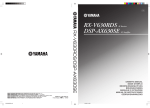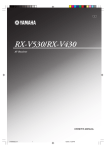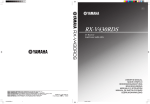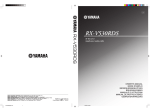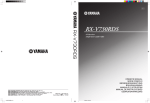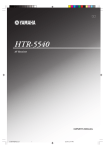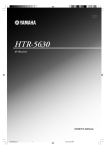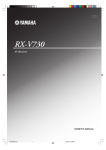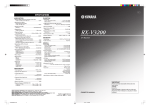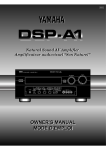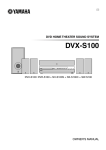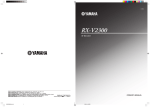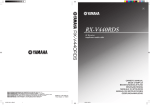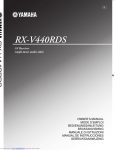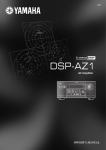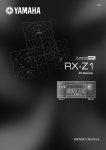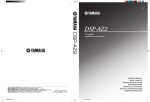Download Yamaha RX-V630 Receiver
Transcript
U RX-V630 AV Receiver OWNER’S MANUAL 0100V630(U)-cv1 1 12/27/01, 7:45 PM SAFETY INSTRUCTIONS 10 CAUTION RISK OF ELECTRIC SHOCK DO NOT OPEN CAUTION: TO REDUCE THE RISK OF ELECTRIC SHOCK, DO NOT REMOVE COVER (OR BACK). NO USER-SERVICEABLE PARTS INSIDE. REFER SERVICING TO QUALIFIED SERVICE PERSONNEL. • 11 Explanation of Graphical Symbols The lightning flash with arrowhead symbol, within an equilateral triangle, is intended to alert you to the presence of uninsulated “dangerous voltage” within the product’s enclosure that may be of sufficient magnitude to constitute a risk of electric shock to persons. The exclamation point within an equilateral triangle is intended to alert you to the presence of important operating and maintenance (servicing) instructions in the literature accompanying the appliance. 12 13 WARNING TO REDUCE THE RISK OF FIRE OR ELECTRIC SHOCK, DO NOT EXPOSE THIS UNIT TO RAIN OR MOISTURE. 14 1 2 3 4 5 6 7 8 9 Read Instructions – All the safety and operating instructions should be read before the product is operated. Retain Instructions – The safety and operating instructions should be retained for future reference. Heed Warnings – All warnings on the product and in the operating instructions should be adhered to. Follow Instructions – All operating and use instructions should be followed. Cleaning – Unplug this product from the wall outlet before cleaning. Do not use liquid cleaners or aerosol cleaners. Use a damp cloth for cleaning. Attachments – Do not use attachments not recommended by the product manufacturer as they may cause hazards. Water and Moisture – Do not use this product near water – for example, near a bath tub, wash bowl, kitchen sink, or laundry tub; in a wet basement; or near a swimming pool; and the like. Accessories – Do not place this product on an unstable cart, stand, tripod, bracket, or table. The product may fall, causing serious injury to a child or adult, and serious damage to the product. Use only with a cart, stand, tripod, bracket, or table recommended by the manufacturer, or sold with the product. Any mounting of the product should follow the manufacturer’s instructions, and should use a mounting accessory recommended by the manufacturer. A product and cart combination should be moved with care. Quick stops, excessive force, and uneven surfaces may cause the product and cart combination to overturn. 15 16 17 18 19 Ventilation – Slots and openings in the cabinet are provided for ventilation and to ensure reliable operation of the product and to protect it from overheating, and these openings must not be blocked or covered. The openings should never be blocked by placing the product on a bed, sofa, rug, or other similar surface. This product should not be placed in a built-in installation such as a bookcase or rack unless proper ventilation is provided or the manufacturer’s instructions have been adhered to. Power Sources – This product should be operated only from the type of power source indicated on the marking label. If you are not sure of the type of power supply to your home, consult your product dealer or local power company. For products intended to operate from battery power, or other sources, refer to the operating instructions. Grounding or Polarization – This product may be equipped with a polarized alternating current line plug (a plug having one blade wider than the other). This plug will fit into the power outlet only one way. This is a safety feature. If you are unable to insert the plug fully into the outlet, try reversing the plug. If the plug should still fail to fit, contact your electrician to replace your obsolete outlet. Do not defeat the safety purpose of the polarized plug. Power-Cord Protection – Power-supply cords should be routed so that they are not likely to be walked on or pinched by items placed upon or against them, paying particular attention to cords at plugs, convenience receptacles, and the point where they exit from the product. Lightning – For added protection for this product during a lightning storm, or when it is left unattended and unused for long periods of time, unplug it from the wall outlet and disconnect the antenna or cable system. This will prevent damage to the product due to lightning and power-line surges. Power Lines – An outside antenna system should not be located in the vicinity of overhead power lines or other electric light or power circuits, or where it can fall into such power lines or circuits. When installing an outside antenna system, extreme care should be taken to keep from touching such power lines or circuits as contact with them might be fatal. Overloading – Do not overload wall outlets, extension cords, or integral convenience receptacles as this can result in a risk of fire or electric shock. Object and Liquid Entry – Never push objects of any kind into this product through openings as they may touch dangerous voltage points or short-out parts that could result in a fire or electric shock. Never spill liquid of any kind on the product. Servicing – Do not attempt to service this product yourself as opening or removing covers may expose you to dangerous voltage or other hazards. Refer all servicing to qualified service personnel. Damage Requiring Service – Unplug this product from the wall outlet and refer servicing to qualified service personnel under the following conditions: a) When the power-supply cord or plug is damaged, b) If liquid has been spilled, or objects have fallen into the product, c) If the product has been exposed to rain or water, I CAUTION 0101V630_Cau_EN(U) 2 12/27/01, 7:45 PM SAFETY SAFETY INSTRUCTIONS INSTRUCTIONS d) 20 21 22 23 If the product does not operate normally by following the operating instructions. Adjust only those controls that are covered by the operating instructions as an improper adjustment of other controls may result in damage and will often require extensive work by a qualified technician to restore the product to its normal operation, e) If the product has been dropped or damaged in any way, and f) When the product exhibits a distinct change in performance - this indicates a need for service. Replacement Parts – When replacement parts are required, be sure the service technician has used replacement parts specified by the manufacturer or have the same characteristics as the original part. Unauthorized substitutions may result in fire, electric shock, or other hazards. Safety Check – Upon completion of any service or repairs to this product, ask the service technician to perform safety checks to determine that the product is in proper operating condition. Wall or Ceiling Mounting – The unit should be mounted to a wall or ceiling only as recommended by the manufacturer. Heat – The product should be situated away from heat sources such as radiators, heat registers, stoves, or other products (including amplifiers) that produce heat. 24 Outdoor Antenna Grounding – If an outside antenna or cable system is connected to the product, be sure the antenna or cable system is grounded so as to provide some protection against voltage surges and built-up static charges. Article 810 of the National Electrical Code, ANSI/ NFPA 70, provides information with regard to proper grounding of the mast and supporting structure, grounding of the lead-in wire to an antenna discharge unit, size of grounding conductors, location of antenna discharge unit, connection to grounding electrodes, and requirements for the grounding electrode. EXAMPLE OF ANTENNA GROUNDING MAST ANTENNA LEAD IN WIRE GROUND CLAMP ANTENNA DISCHARGE UNIT (NEC SECTION 810–20) ELECTRIC SERVICE EQUIPMENT GROUNDING CONDUCTORS (NEC SECTION 810–21) GROUND CLAMPS Note to CATV system installer: This reminder is provided to call the CATV system installer’s attention to Article 820-40 of the NEC that provides guidelines for proper grounding and, in particular, specifies that the cable ground shall be connected to the grounding system of the building, as close to the point of cable entry as practical. POWER SERVICE GROUNDING ELECTRODE SYSTEM (NEC ART 250. PART H) NEC – NATIONAL ELECTRICAL CODE FCC INFORMATION (for US customers only) 1. 2. 3. IMPORTANT NOTICE : DO NOT MODIFY THIS UNIT! This product, when installed as indicated in the instructions contained in this manual, meets FCC requirements. Modifications not expressly approved by Yamaha may void your authority, granted by the FCC, to use the product. IMPORTANT : When connecting this product to accessories and/or another product use only high quality shielded cables. Cable/s supplied with this product MUST be used. Follow all installation instructions. Failure to follow instructions could void your FCC authorization to use this product in the USA. NOTE : This product has been tested and found to comply with the requirements listed in FCC Regulations, Part 15 for Class “B” digital devices. Compliance with these requirements provides a reasonable level of assurance that your use of this product in a residential environment will not result in harmful interference with other electronic devices. This equipment generates/uses radio frequencies and, if not installed and used according to the instructions found in the users manual, may cause interference harmful to the operation of other electronic devices. Compliance with FCC regulations does not guarantee that interference will not occur in all installations. If this product is found to be the source of interference, which can be determined by turning the unit “OFF” and “ON”, please try to eliminate the problem by using one of the following measures: Relocate either this product or the device that is being affected by the interference. Utilize power outlets that are on different branch (circuit breaker or fuse) circuits or install AC line filter/s. In the case of radio or TV interference, relocate/reorient the antenna. If the antenna lead-in is 300 ohm ribbon lead, change the lead-in to coaxial type cable. If these corrective measures do not produce satisfactory results, please contact the local retailer authorized to distribute this type of product. If you can not locate the appropriate retailer, please contact Yamaha Electronics Corp., U.S.A. 6660 Orangethorpe Ave, Buena Park, CA 90620. The above statements apply ONLY to those products distributed by Yamaha Corporation of America or its subsidiaries. CAUTION II 0101V630_Cau_EN(U) 3 12/27/01, 7:45 PM CAUTION: READ THIS BEFORE OPERATING YOUR UNIT. 1 2 3 4 5 6 7 8 9 10 11 12 To assure the finest performance, please read this manual carefully. Keep it in a safe place for future reference. Install this unit in a well ventilated, cool, dry, clean place with at least 30 cm on the top, 20 cm on the left and right, and 10 cm at the back of this unit — away from direct sunlight, heat sources, vibration, dust, moisture, and/or cold. Locate this unit away from other electrical appliances, motors, or transformers to avoid humming sounds. To prevent fire or electrical shock, do not place this unit where it may get exposed to rain, water, and/or any type of liquid. Do not expose this unit to sudden temperature changes from cold to hot, and do not locate this unit in a environment with high humidity (i.e. a room with a humidifier) to prevent condensation inside this unit, which may cause an electrical shock, fire, damage to this unit, and/or personal injury. On the top of this unit, do not place: – Other components, as they may cause damage and/or discoloration on the surface of this unit. – Burning objects (i.e. candles), as they may cause fire, damage to this unit, and/or personal injury. – Containers with liquid in them, as they may cause electrical shock to the user and/or damage to this unit. Do not cover this unit with a newspaper, tablecloth, curtain, etc. in order not to obstruct heat radiation. If the temperature inside this unit rises, it may cause fire, damage to this unit, and/or personal injury. Do not plug in this unit to a wall outlet until all connections are complete. Do not operate this unit upside-down. It may overheat, possibly causing damage. Do not use force on switches, knobs and/or cords. When disconnecting the power cord from the wall outlet, grasp the plug; do not pull the cord. Do not clean this unit with chemical solvents; this might damage the finish. Use a clean, dry cloth. Only voltage specified on this unit must be used. Using this unit with a higher voltage than specified is dangerous and may cause fire, damage to this unit, and/or personal injury. YAMAHA will not be held responsible for any damage resulting from use of this unit with a voltage other than specified. 13 14 15 16 17 18 19 To prevent damage by lightning, disconnect the power cord from the wall outlet during an electrical storm. Take care of this unit so that no foreign objects and/or liquid drops inside this unit. Do not attempt to modify or fix this unit. Contact qualified YAMAHA service personnel when any service is needed. The cabinet should never be opened for any reasons. When not planning to use this unit for long periods of time (i.e. vacation), disconnect the AC power plug from the wall outlet. Be sure to read the “TROUBLESHOOTING” section on common operating errors before concluding that this unit is faulty. Before moving this unit, press STANDBY/ON to set this unit in the standby mode, and disconnect the AC power plug from the wall outlet. VOLTAGE SELECTOR (China and General models only) The VOLTAGE SELECTOR on the rear panel of this unit must be set for your local main voltage BEFORE plugging into the AC main supply. Voltages are 110/120/220/240 V AC, 50/60 Hz. This unit is not disconnected from the AC power source as long as it is connected to the wall outlet, even if this unit itself is turned off. This state is called the standby mode. In this state, this unit is designed to consume a very small quantity of power. IMPORTANT Please record the serial number of this unit in the space below. MODEL: Serial No.: The serial number is located on the rear of the unit. Retain this Owner’s Manual in a safe place for future reference. FOR CANADIAN CUSTOMERS To prevent electric shock, match wide blade of plug to wide slot and fully insert. This Class B digital apparatus complies with Canadian ICES-003. We Want You Listening For A Lifetime YAMAHA and the Electronic Industries Association’s Consumer Electronics Group want you to get the most out of your equipment by playing it at a safe level. One that lets the sound come through loud and clear without annoying blaring or distortion – and, most importantly, without affecting your sensitive hearing. Since hearing damage from loud sounds is often undetectable until it is too late, YAMAHA and the Electronic Industries Association’s Consumer Electronics Group recommend you to avoid prolonged exposure from excessive volume levels. III CAUTION 0101V630_Cau_EN(U) 4 12/27/01, 7:45 PM INTRODUCTION CONTENTS CONTENTS ............................................................ 1 FEATURES ............................................................. 2 GETTING STARTED ............................................ 3 Checking the package contents ................................. 3 Installing batteries in the remote control ................... 3 CONTROLS AND FUNCTIONS ......................... 4 PREPARATION SET MENU ........................................................... 40 Adjusting the items on the SET MENU .................. 40 1 SPEAKER SET (speaker mode settings) ............ 41 2 LFE LEVEL ........................................................ 43 3 SP DLY TIME (speaker delay time) ................... 43 4 D. RANGE (dynamic range) ............................... 44 5 L/R BALANCE (balance of the main left and right speakers) ..................................................... 44 6 HP TONE CTRL (headphone tone control) ........ 44 7 I/O ASSIGN (input/output assignment) .............. 44 8 INPUT MODE (initial input mode) .................... 45 9 DISPLAY SET .................................................... 45 10MEM. GUARD (memory guard) ........................ 45 PREPARATION Front panel ................................................................ 4 Remote control .......................................................... 6 Using the remote control ........................................... 7 Front panel display .................................................... 8 INTRODUCTION ADVANCED OPERATION INTRODUCTION REMOTE CONTROL FEATURES ................... 46 SPEAKER SETUP ................................................. 9 Speakers .................................................................... 9 Speaker placement .................................................... 9 Connecting the speakers .......................................... 10 Before connecting components ............................... 13 Connecting video components ................................ 14 Connecting audio components ................................ 16 Connecting the antennas ......................................... 17 Connecting an external amplifier ............................ 18 Connecting an external decoder .............................. 18 Connecting the power supply cords ........................ 19 Turning on the power .............................................. 19 Before you begin ..................................................... 21 Using the test tone ................................................... 21 Changing parameter settings ................................... 51 PRO LOGIC Music parameter descriptions ....... 51 ADDITIONAL INFORMATION ADVANCED OPERATION SPEAKER MODE SETTINGS .......................... 20 ADJUSTING SPEAKER OUTPUT LEVELS .. 21 ADJUSTING THE LEVEL OF THE EFFECT SPEAKERS ....................................................... 49 ADJUSTING THE DELAY TIME ..................... 50 ADJUSTING THE PARAMETER SETTINGS FOR PRO LOGIC MUSIC ......................... 51 BASIC OPERATION CONNECTIONS .................................................. 13 Control area ............................................................. 46 Setting the manufacturer code ................................. 47 Clearing setup manufacturer codes ......................... 47 Controlling other components ................................. 48 TROUBLESHOOTING ...................................... 52 GLOSSARY .......................................................... 56 SPECIFICATIONS .............................................. 58 BASIC OPERATION BASIC PLAYBACK ............................................ 23 ADDITIONAL INFORMATION Input modes and indications .................................... 25 Selecting a sound field program .............................. 26 DIGITAL SOUND FIELD PROCESSING (DSP) ................................................................. 29 Understanding sound fields ..................................... 29 Hi-Fi DSP programs ................................................ 29 CINEMA-DSP ...................................................... 30 Sound design of CINEMA-DSP ............................. 30 CINEMA-DSP programs ........................................ 32 TUNING ................................................................ 34 Automatic and manual tuning ................................. 34 Presetting stations .................................................... 35 Tuning in to a preset station .................................... 37 Exchanging preset stations ...................................... 37 SLEEP TIMER ..................................................... 38 Setting the sleep timer ............................................. 38 Canceling the sleep timer ........................................ 38 RECORDING ....................................................... 39 English 1 0102V630_1-8_EN(U) 1 12/27/01, 7:45 PM FEATURES Built-in 6-channel power amplifier Other features ◆ Minimum RMS output power (0.06% THD, 20 Hz – 20 kHz, 8Ω) Main: 75 W + 75 W Center: 75 W Rear: 75 W + 75 W Rear center: 75 W ◆ 96-kHz/24-bit D/A converter ◆ “SET MENU” for optimizing this unit for your Audio/Video system ◆ Test tone generator for easier speaker balance adjustment ◆ 6-channel external decoder input ◆ S-video signal input/output capability ◆ Component video input/output capability ◆ Optical and coaxial digital audio signal jacks ◆ Sleep timer ◆ Remote control with preset manufacturer codes Multi-mode digital sound field processing ◆ ◆ ◆ ◆ Dolby Pro Logic/Dolby Pro Logic decoder Dolby Digital/Dolby Digital EX decoder DTS/DTS-ES compatible decoder CINEMA DSP: Combination of YAMAHA DSP technology and Dolby Pro Logic, Dolby Digital or DTS ◆ Virtual CINEMA DSP ◆ SILENT CINEMA DSP Sophisticated AM/FM Tuner ◆ 40-Station random access preset tuning ◆ Automatic preset tuning ◆ Preset station shifting capability (Preset editing) ■ About this manual • y indicates a tip for your operation. • Some operations can be performed by using either the buttons on the main unit or on the remote control. In cases when the button names differ between the main unit and the remote control, the button name on the remote control is given in parentheses. • This manual is printed prior to production. Design and specifications are subject to change in part for the reason of the improvement in operativity ability, and others. In this case, the product has priority. Manufactured under license from Dolby Laboratories. “DTS”, “ES” and “DTS Digital Surround” are trademarks of Digital Theater Systems, Inc. “Dolby”, “Pro Logic”, and the double-D symbol are trademarks of Dolby Laboratories. 2 0102V630_1-8_EN(U) 2 12/27/01, 7:45 PM GETTING STARTED INTRODUCTION Checking the package contents Check your package to make sure it contains the following items. Remote control AM loop antenna Indoor FM antenna (U.S.A., Canada, China, Korea and General models) Front VIDEO AUX jack cap 75-ohm/300-ohm antenna adapter (U.K. model) (Europe, U.K., Australia and Singapore models) SYSTEM POWER STANDBY POWER POWER TV AV CD MD/CD-R TUNER SLEEP DVD D-TV/CBL V-AUX 6CH INPUT VCR 1 VCR2/DVR A AMP + + + TV VOL TV CH VOLUME – – TV MUTE TV INPUT PREPARATION Batteries (4) (AAA, R03, UM-4) TRANSMIT CODE SET – MUTE HALL JAZZ CLUB ROCK CONCERT ENTERTAINMENT 1 2 3 4 TV SPORTS MONO MOVIE MOVIE THEATER 1 MOVIE THEATER 2 5 6 7 8 SELECT EX/ES STEREO 0 +10 /DTS SUR. 9 ENTER EFFECT LEVEL PRESET/CH SET MENU MENU TITLE A/B/C/D/E SELECT + BASIC OPERATION – TEST RETURN DISPLAY REC AUDIO DISC SKIP Insert the batteries in the correct direction by aligning the + and – marks on the batteries with the polarity markings (+ and –) inside the battery compartment. 1 • Change all of the batteries if you notice a decrease in the operating range of the remote control, that the indicator does not flash, or the light becoming dim. • Do not use old batteries together with new ones. • Do not use different types of batteries (such as alkaline and manganese batteries) together. Read the packaging carefully as these different types of batteries may have the same shape and color. • If the batteries have leaked, dispose of them immediately. Avoid touching the leaked material or letting it come into contact with clothing, etc. Clean the battery compartment thoroughly before installing new batteries. Press the part and slide off the battery compartment cover. 2 Insert the four supplied batteries (AAA, R03, UM-4) according to the polarity markings on the inside of the battery compartment. 3 Slide the cover back on so that it snaps into place. English 1 APPENDIX If the remote control is without batteries for more than 2 minutes, or if exhausted batteries remain in the remote control, the contents of the memory may be cleared. When the memory is cleared, insert new batteries, set up the manufacturer code that may have been cleared. 3 3 0102V630_1-8_EN(U) 3 ADDITIONAL INFORMATION 2 ■ Notes on batteries ADVANCED OPERATION Installing batteries in the remote control 12/27/01, 7:45 PM CONTROLS AND FUNCTIONS Front panel 1 2 3 4 5 6 INPUT 7 VOLUME INPUT M0DE 6CH INPUT NATURAL SOUND AV RECEIVER PRESET/TUNING FM/AM EDIT STANDBY /ON TUNING MODE MEMORY AUTO/MAN'L MONO MAN'L/AUTO FM BASS SILENT TREBLE SPEAKERS A B VIDEO AUX STEREO PROGRAM PRESET/TUNING A/B/C/D/E EFFECT – PHONES 8 9 0 q w e + – r + S VIDEO VIDEO t L AUDIO R OPTICAL y PRESET/TUNING FM/AM EDIT TUNING MODE MEMORY AUTO/MAN'L MONO MAN'L/AUTO FM ui o p 1 STANDBY/ON 5 INPUT l / h Turns this unit on, or set it to the standby mode. When you turn this unit on, you will hear a click and there will be a 4 to 5-second delay before this unit can reproduce sound. Selects the input source you want to listen to or watch. Standby mode In this mode, this unit will consume a small amount of power in order to receive infrared-signals from the remote control. 2 Remote control sensor Receives signals from the remote control. 6 VOLUME Controls the output level of all audio channels. This does not affect the OUT (REC) level. 7 6CH INPUT Selects the audio source connected to the 6CH INPUT jacks. This audio takes priority over the source selected with INPUT l / h (or the input selector buttons on the remote control). Shows information about the operational status of this unit. 8 SILENT (PHONES jack) Allows you enjoy DSP effect for private listening with headphones. When you connect headphones, no signals are output to the speakers or the OUTPUT jacks. 4 INPUT MODE 9 SPEAKERS A/B Sets the priority for the types of input signals (AUTO, DTS, ANALOG) to receive when one component is connected to two or more input jacks. Priority cannot be set when 6CH INPUT is selected as the input source. Turns the set of main speakers connected to the A and/or B terminals on or off. 3 Front panel display 4 0102V630_1-8_EN(U) 4 12/27/01, 7:45 PM CONTROLS AND FUNCTIONS 0 STEREO/EFFECT q PROGRAM l / h Selects the DSP program. w PRESET/TUNING l / h i TUNING MODE (AUTO/MAN’L MONO) Switches the tuning mode between automatic and manual. o MEMORY (MAN’L/AUTO FM) Stores the current station in the memory. p FM/AM Switches the reception band between FM and AM. PREPARATION Selects preset station numbers 1 to 8 when the colon (:) appears in the front panel display. Selects the tuning frequency when the colon (:) does not appear. u PRESET/TUNING (EDIT) Switches the function of PRESET/TUNING l / h between selecting a preset station number and tuning (the colon (:) turns on or off). This button is also used to exchange the assignment of two preset stations with each other. INTRODUCTION Switches between normal stereo and DSP effect reproduction. When STEREO is selected, 2-channel signals are directed to the main left and right speakers without effect sounds and all Dolby Digital and DTS signals (except the LFE channel) are mixed down to the main left and right speakers. e A/B/C/D/E Selects preset station groups A to E. r BASS BASIC OPERATION Adjusts the low-frequency response for the main left and right channels. Turn right to increase or turn left to decrease the lowfrequency response. t TREBLE Adjusts the high-frequency response for the main left and right channels. Turn right to increase or turn left to decrease the highfrequency response. ADVANCED OPERATION y VIDEO AUX jacks EO ADDITIONAL INFORMATION Inputs for audio and video signals from a portable external source (game console, etc.). Set the input source to V-AUX to enjoy source signals from these jacks. When the VIDEO AUX jacks on the front panel are not used, you can attach the provided front VIDEO AUX jack cap as shown in the illustration. When the cap is not attached, be sure retain it carefully. X AU VID AL TIC OP L AU DIO R EO VID IDEO SV APPENDIX English 5 0102V630_1-8_EN(U) 5 12/27/01, 7:45 PM CONTROLS AND FUNCTIONS Remote control This section describes the remote control controls and their functions. Make sure that the AMP mode is selected before starting operation. See “REMOTE CONTROL FEATURES” on pages 46 to 48. 1 2 TRANSMIT CODE SET SYSTEM STANDBY POWER POWER TV AV CD MD/CD-R TUNER SLEEP DVD D-TV/CBL V-AUX 6CH INPUT VCR 1 VCR2/DVR 9 3 Input selector buttons 0 Select the input source and set the remote control to operate the selected source component. q 4 DSP program w Select DSP programs for the AMP position. Press a button repeatedly to select a DSP program within that group. e r + + + TV VOL TV CH VOLUME – – – TV MUTE TV INPUT t y HALL JAZZ CLUB ROCK CONCERT 1 2 3 4 TV SPORTS MONO MOVIE MOVIE THEATER 1 MOVIE THEATER 2 5 6 7 8 SELECT EX/ES STEREO 0 +10 /DTS SUR. 9 ENTERTAINMENT ENTER LEVEL PRESET/CH A/B/C/D/E 6 – SELECT + 8 TRANSMIT indicator u Flashes while the remote control is sending signals. 9 STANDBY i Sets this unit in the standby mode. 0 SYSTEM POWER Turns on the power of this unit. TEST 7 Used when changing the setting and to implement the settings. Outputs the test tone to adjust the speaker levels. SET MENU MENU TITLE 6 Multi control section 7 TEST EFFECT 5 5 LEVEL Selects the effect speaker channel to be adjusted. MUTE 4 2 CODE SET Used when setting up the manufacturer code (see page 47). AMP A Outputs infrared control signals. Aim this window at the component you want to operate. 8 POWER 3 1 Infrared window DISPLAY RETURN REC AUDIO DISC SKIP q SLEEP Sets the sleep timer. w 6CH INPUT Selects the audio source connected to the 6CH INPUT jacks. e AMP Sets the remote control to the AMP mode for controlling this unit. r Å Sets the remote control to operate other component (not necessarily connected to this unit) without changing this unit’s input source. t VOLUME +/– Increases or decreases the volume level. y MUTE Mutes the sound. Press again to restore the audio output to the previous volume level. 6 0102V630_1-8_EN(U) 6 12/27/01, 7:45 PM CONTROLS AND FUNCTIONS u STEREO/EFFECT Using the remote control INPUT VOLUME INPUT M0DE 6CH INPUT NATURAL SOUND AV RECEIVER PRESET/TUNING FM/AM EDIT STANDBY /ON TUNING MODE MEMORY AUTO/MAN'L MONO MAN'L/AUTO FM BASS SILENT i SET MENU INTRODUCTION Switches between normal stereo and DSP effect reproduction. When STEREO is selected, 2-channel signals are directed to the main left and right speakers without effect sounds and all Dolby Digital and DTS signals (except the LFE channel) are mixed down to the main left and right speakers. TREBLE SPEAKERS A B VIDEO AUX PROGRAM STEREO PRESET/TUNING A/B/C/D/E EFFECT – PHONES + – + S VIDEO VIDEO L AUDIO R OPTICAL Selects the SET MENU mode. 30° 30° PREPARATION VCR 1 Approximately 6 m (20 feet) VCR2/DVR ■ Handling the remote control ADVANCED OPERATION • Do not spill water or other liquids on the remote control. • Do not drop the remote control. • Do not leave or store the remote control in the following types of conditions: – high humidity or temperature such as near a heater, stove or bath; – dusty places; or – in places subject to extremely low temperatures. BASIC OPERATION The remote control transmits a directional infrared beam. Be sure to aim the remote control directly at the remote control sensor on the main unit during operation. ADDITIONAL INFORMATION APPENDIX English 7 0102V630_1-8_EN(U) 7 12/27/01, 7:45 PM CONTROLS AND FUNCTIONS Front panel display 1 MATRIX 2 VCR2/DVR DIGITAL VIRTUAL SILENT PRO LOGIC / VCR1 V-AUX D-TV/CBL 3 DVD DTS DOLBY DIGITAL PRO LOGIC MOVIE THTR 12 ENTERTAINMENT MD/CD-R TUNER CD STEREO AUTO MUTE VOLUME TUNED MEMORY SLEEP L DSP dB mS PCM 5 4 6 7 8 9 C R LFE RL RC RR 0 q w e r t 1 Processor indicators 0 STEREO indicator Lights up when the t, g, VIRTUAL, PRO LOGIC / or DSP are activated. Lights up when this unit is receiving a strong signal for an FM stereo broadcast while the “AUTO” indicator is lit. MATRIX lights up when the Dolby Digital EX decoder or the DTS-ES compatible decoder is activated. q TUNED indicator 2 Input source indicator w MEMORY indicator Shows the current input source with a cursor. 3 MUTE indicator Flashes while the MUTE function is on. 4 VOLUME level indicator Indicates the volume level. 5 v indicator Lights up when this unit is reproducing PCM (pulse code modulation) digital audio signals. Lights up when this unit is tuned to a station. Flashes to show a station can be stored. e AUTO indicator Shows that this unit is in the automatic tuning mode. r SLEEP indicator Lights up while the sleep timer is on. t Input channel indicator Indicates the channel components of input signals being received. 6 SILENT indicator Lights up when headphones are connected while the digital sound field processor is on. 7 Headphones indicator Lights up when headphones are connected. 8 DSP program indicators The name of the selected DSP program lights up when the ENTERTAINMENT, MOVIE THEATER 1, MOVIE THEATER 2 or V/DTS SURROUND DSP program is selected. 9 Multi-information display Shows the current DSP program name and other information when adjusting or changing settings. 8 0102V630_1-8_EN(U) 8 12/27/01, 7:45 PM PREPARATION SPEAKER SETUP Speaker placement ■ Use of a subwoofer expands your sound field Rear speaker (R) Subwoofer Main speaker (L) 1.8 m (6 feet) Rear center speaker Rear speaker (L) ■ Main speakers Place the main left and right speakers an equal distance from the ideal listening position. The distance between each speaker and each side of the video monitor should also be the same. ■ Center speaker Align the front face of the center speaker with the front face of your video monitor. Place the speaker as close to the monitor as possible (such as directly over or under the monitor) and centrally between the main speakers. ■ Rear speakers Place these speakers behind your listening position, facing slightly inwards, nearly 1.8 m (6 feet) above the floor. ■ Rear center speaker Place the rear center speaker in the center between the rear left and right speakers at the same height from the floor as the rear speakers. ■ Subwoofer Note • If you do not use any of effect speakers (rear, center and/or rear center), change the settings of SPEAKER SET items at the SET MENU to designate the signals to other terminals you connect speakers to. English CAUTION Use magnetically shielded speakers. If this type of speakers still creates the interference with the monitor, place the speakers away from the monitor. 9 0103V630_9-18_EN(U) 9 12/27/01, 7:45 PM APPENDIX The position of the subwoofer is not so critical, because low bass sounds are not highly directional. But it is better to place the subwoofer near the main speakers. Turn it slightly toward the center of the room to reduce wall reflections. ADDITIONAL INFORMATION It is also possible to further expand your system with the addition of a subwoofer. The use of a subwoofer is effective not only for reinforcing bass frequencies from any or all channels, but also for reproducing the LFE (low-frequency effect) channel with high fidelity when playing back Dolby Digital or DTS signals. The YAMAHA Active Servo Processing Subwoofer System is ideal for natural and lively bass reproduction. Main speaker (R) ADVANCED OPERATION The main speakers should be high-performance models and have enough power-handling capacity to accept the maximum output of your audio system. The other speakers do not have to be equal to the main speakers. For precise sound localization, however, it is ideal to use the models of equivalent performance with the main speakers. Center speaker BASIC OPERATION The main speakers are used for the main source sound plus effect sounds. They will probably be the speakers from your present stereo system. The rear speakers are used for effect and surround sounds. The center speaker is for the center sounds (dialog, vocals, etc.). The rear center speaker supplements the rear (left and right) speakers and provides for more realistic front-to-back transitions. Refer to the following diagram when you place the speakers. PREPARATION This unit has been designed to provide the best soundfield quality with a 6-speaker system, using main left and right speakers, rear left and right speakers, a center speaker, and a rear center speaker. If you use different brands of speakers (with different tonal qualities) in your system, the tone of a moving human voice and other types of sound may not shift smoothly. We recommend that you use speakers from the same manufacturer or speakers with the same tonal quality. INTRODUCTION Speakers SPEAKER SETUP Connecting the speakers Be sure to connect the left channel (L), right channel (R), “+” (red) and “–” (black) properly. If the connections are faulty, no sound will be heard from the speakers, and if the polarity of the speaker connections is incorrect, the sound will be unnatural and lack bass. CAUTION • Use speakers with the specified impedance shown on the rear panel of this unit. • Do not let the bare speaker wires touch each other or any metal part of this unit. This could damage this unit and/or the speakers. If necessary, use the SET MENU to change the speaker mode settings according to the number and size of the speakers in your configuration after you finish connecting your speakers. ■ Speaker cables A speaker cord is actually a pair of insulated cables running side by side. One cable is colored or shaped differently, perhaps with a stripe, groove or ridge. 10 mm (3/8”) 1 2 1 Remove approximately 10 mm (3/8”) of insulation from each of the speaker cables. 2 Twist the exposed wires of the cable together to prevent short circuits. ■ Connecting to the SPEAKERS terminals 2 Red: positive (+) Black: negative (–) 3 1 1 2 Unscrew the knob. 3 Tighten the knob to secure the wire. Insert one bare wire into the hole in the side of each terminal. (U.S.A. model) y Banana plug (U.S.A., Canada, Australia, China, Korea and General models) • Banana plug connections are also possible. First, tighten the knob and then insert the banana plug connector into the end of the corresponding terminal. (U.S.A. model) ■ MAIN SPEAKERS terminals One or two speaker systems can be connected to these terminals. When using only one speaker system, it can be connected to either the MAIN A or the MAIN B terminals. ■ REAR SPEAKERS terminals A rear speaker system can be connected to these terminals. ■ CENTER SPEAKER terminals A center speaker can be connected to these terminals. ■ REAR CENTER SPEAKER terminals A rear center speaker can be connected to these terminals. 10 0103V630_9-18_EN(U) 10 12/27/01, 7:45 PM SPEAKER SETUP Main B speaker Right Main A speaker Left Right Left Center speaker 2 VIDEO AUDIO L R S VIDEO + DVD COMPONENT VIDEO PB/CB PR/CR GND B Y DVD AC OUTLETS IN MAIN D-TV /CBL DVD UNBAL. D-TV /CBL R FM ANT 6CH INPUT VIDEO MONITOR OUT OUTPUT MAIN A OR B: 8 A+B:16 : 8 CENTER REAR CENTER : 8 : 8 REAR REAR CENTER MIN. /SPEAKER MIN. /SPEAKER MIN. /SPEAKER MIN. /SPEAKER MIN. /SPEAKER CENTER R L IMPEDANCE SELECTOR 5 4 6 Right 7 Left Rear speaker ADVANCED OPERATION Subwoofer system 3 REAR (SURROUND) SET BEFORE POWER ON BASIC OPERATION DIGITAL OUTPUT S VIDEO L OUTPUT L MAIN MAIN A OR B :4 MIN. /SPEAKER A+B :8 MIN. /SPEAKER CENTER :6 MIN. /SPEAKER REAR CENTER :6 MIN. /SPEAKER REAR :6 MIN. /SPEAKER SUB WOOFER REAR (SURROUND) R L R MONITOR OUT SUB WOOFER CENTER + + SURROUND MD/CD-R OPTICAL – – OUT VCR 1 75 MD/CD-R – TUNER AM ANT OUT (REC) MD /CD-R IN (PLAY) – PREPARATION – IN CD + A VCR 2 /VDR CD CENTER + VIDEO OUT COAXIAL OPTICAL D-TV/CBL 3 SPEAKERS REAR CENTER L MAIN R AUDIO DIGITAL INPUT INTRODUCTION 1 Rear center speaker 1 4 2 ADDITIONAL INFORMATION 5 7 6 The diagram shows the speaker layout in the listening room. When using a subwoofer with built-in amplifier, including the YAMAHA Active Servo Processing Subwoofer System, connect the input jack of the subwoofer system to this jack. Low bass signals distributed from the main, center and/or rear channels are directed to this jack in accordance with your SPEAKER SET selections. The LFE (low-frequency effect) signals generated when Dolby Digital or DTS is decoded are also directed to this jack in accordance with your SPEAKER SET selections. 11 0103V630_9-18_EN(U) 11 12/27/01, 7:45 PM English Notes • The cut-off frequency of the SUBWOOFER jack is 90 Hz. • If you do not use a subwoofer, designate the signals to the main left and right speakers by changing the setting of SPEAKER SET item “1E BASS” on the SET MENU to MAIN. • Use the control on the subwoofer to adjust its volume level. It is also possible to adjust the volume level by using this unit’s remote control (see “ADJUSTING THE LEVEL OF THE EFFECT SPEAKERS” on page 49). APPENDIX ■ SUBWOOFER jack SPEAKER SETUP ■ IMPEDANCE SELECTOR switch WARNING Do not change setting of the IMPEDANCE SELECTOR switch when the power of this unit is on, this may damage the unit. If this unit fails to turn on when STANDBY/ON (or SYSTEM POWER) is pressed, the IMPEDANCE SELECTOR switch may not be fully slid to either position. If so, slide the switch all the way to either position when this unit is in the standby mode. Select the switch position (left or right) according to the impedance of the speakers in your system. Be sure to move this switch only when this unit is in the standby mode. IMPEDANCE SELECTOR switch Switch position Speaker Main MAIN A OR B: 8 A+B:16 : 8 CENTER REAR CENTER: 8 : 8 REAR MAIN A OR B :4 MIN. /SPEAKER A+B :8 MIN. /SPEAKER CENTER :6 MIN. /SPEAKER REAR CENTER :6 MIN. /SPEAKER REAR :6 MIN. /SPEAKER MIN. /SPEAKER MIN. /SPEAKER MIN. /SPEAKER MIN. /SPEAKER MIN. /SPEAKER SET BEFORE POWER ON Impedance level If you use one set of main speakers, the impedance of each speaker must be 4 Ω or higher. If you use two sets of main speakers, the impedance of each speaker must be 8 Ω or higher. IMPEDANCE SELECTOR Left SPEAKERS REAR CENTER L MAIN R + CENTER + + – – A – Center The impedance must be 6 Ω or higher. Rear Center The impedance must be 6 Ω or higher. Rear – – OMPONENT VIDEO R/CR PB/CB B Y REAR (SURROUND) R L Main If you use one set of main speakers, the impedance of each speaker must be 8 Ω or higher. If you use two sets of main speakers, the impedance of each speaker must be 16 Ω or higher. [Canada model only] The impedance of each speaker must be 8 Ω or higher. Center The impedance must be 8 Ω or higher. Rear Center The impedance must be 8 Ω or higher. + + R L OUTPUT L R MAIN MAIN A OR B :4 MIN. /SPEAKER A+B :8 MIN. /SPEAKER CENTER :6 MIN. /SPEAKER REAR CENTER :6 MIN. /SPEAKER REAR :6 MIN. /SPEAKER The impedance of each speaker must be 6 Ω or higher. MAIN A OR B: 8 A+B:16 : 8 CENTER REAR CENTER: 8 : 8 REAR REAR CENTER MIN. /SPEAKER MIN. /SPEAKER MIN. /SPEAKER MIN. /SPEAKER MIN. /SPEAKER CENTER R REAR (SURROUND) L SET BEFORE POWER ON IMPEDANCE SELECTOR (U.S.A. model) Right Rear The impedance of each speaker must be 8 Ω or higher. 12 0103V630_9-18_EN(U) 12 12/27/01, 7:45 PM CONNECTIONS This unit has digital jacks for direct transmission of digital signals through either coaxial or fiber optic cables. You can use the digital jacks to input PCM, Dolby Digital and DTS bitstreams. To enjoy multi-channel sound track of DVD software, etc. with DSP effect, you need to make digital connection. All digital input jacks are acceptable for 96-kHz sampling digital signals. CAUTION Do not connect this unit or other components to the mains power until all connections between the components have been completed. BASIC OPERATION DIGITAL INPUT jacks (pages 13-16) Note • The OPTICAL jacks on this unit conform to the EIA standard. If you use a fiber optic cable that does not conform to this standard, this unit may not function properly. Antenna input terminals (page 17) Speaker terminals (pages 10-11) MAIN R AUDIO DIGITAL INPUT AUDIO SPEAKERS REAR CENTER L + VIDEO S VIDEO VIDEO L R ADVANCED OPERATION Video component jacks (pages 14-15) Audio component jacks (page 16) L VCR 2 /VDR DVD – IN CD COMPONENT VIDEO PR/CR PB/CB GND DVD D-TV /CBL SURROUND DVD UNBAL. D-TV /CBL FM ANT SUB WOOFER 6CH INPUT R REAR (SURROUND) R L R MAIN L REAR CENTER CENTER R S VIDEO L OUTPUT MONITOR OUT DIGITAL OUTPUT + + MAIN SUB WOOFER CENTER – B Y IN MD/CD-R OPTICAL – – OUT VCR 1 75 MD/CD-R – TUNER AM ANT OUT (REC) MD /CD-R IN (PLAY) + ADDITIONAL INFORMATION R CD CENTER + A OUT COAXIAL OPTICAL D-TV/CBL PREPARATION • Be sure all connections are made correctly, that is to say L (left) to L, R (right) to R, “+” to “+” and “–” to “–”. Some components require different connection methods and have different jack names. Refer to the operation instructions for each component to be connected to this unit. • When you connect other YAMAHA audio components (such as a tape deck, MD recorder and CD player or changer), connect them to the jack with the same number labels as !, #, $ etc. YAMAHA applies this labeling system to all its products. • After you have completed all connections, check them again to make sure they are correct. • The name of jack corresponds to input selector. INTRODUCTION ■ Connecting to digital jacks Before connecting components REAR (SURROUND) L VIDEO MONITOR OUT OUTPUT SUBWOOFER OUTPUT jack (page 11) DIGITAL OUTPUT jack (page 16) APPENDIX 6CH INPUT jacks (page 18) AC OUTLETS (page 19) OUTPUT jacks (page 18) English 13 0103V630_9-18_EN(U) 13 12/27/01, 7:45 PM CONNECTIONS Connecting video components Refer to the connection examples on the next page. ■ Types of video jacks There are three types of video jacks as follows: COMPONENT VIDEO S VIDEO VIDEO 2 1 PR/CR PB/CB Y 3 1 VIDEO jack Conventional composite video signal. 2 S VIDEO jack Transmits color and luminance separately and achives high-quality color reproduction. 3 COMPONENT VIDEO jacks Transmit color difference (PB/CB, PR/CR) and luminance separately and provide the best quality picture. • Each type of video jack works independently. Signals input through the composite video, S-video and component jacks are only output through the corresponding composite video, S-video, and component jacks. • Use a commercially available cable specified for connecting each type of jacks. • The description of the component video jacks may differ depending on the component (e.g. Y, CB, CR/Y, PB, PR/Y, B-Y, R-Y etc.). When using these jacks, refer also to the operation instructions for the component being connected. ■ Connecting a video monitor Connect the video input jack on your video monitor to the MONITOR OUT VIDEO jack. Note • If you connect this unit with a source component using S-video (or Component video) jacks, you also need to connect your video monitor using S-video (or Component video) jacks. ■ Connecting a DVD player/digital TV/cable TV Connect the optical digital audio signal output jack on your component to the DIGITAL INPUT jack and connect the video signal output jack on the component to the VIDEO jack on this unit. Then connect AUDIO jacks on your component to the AUDIO jacks on this unit. y • If your video component has an S-video output or component video output, connect the S-video signal output jack on the component to the S VIDEO jack or connect the component video signal output jacks on the component to the COMPONENT VIDEO jacks. • The AUDIO jacks are available for a video component which does not have optical digital output jack. However, multichannel reproduction cannot be obtained with audio signals input from AUDIO jacks. ■ Connecting a game console or camcorder Connect the optical digital audio signal output jack on your video component to the OPTICAL jack on the front panel and connect video signal output jack on the component to the VIDEO jack on the front panel. y • If your video component has an S-video output, connect the Svideo signal output jack on the component to the S VIDEO jack. • The AUDIO jacks are available for a video component such as a camcorder which does not have optical digital output jack. ■ Connecting a VCR or DVR (digital video recorder) Connect the audio signal input jacks on your video component to the AUDIO OUT jacks and connect the video signal input jack on the video component to the VIDEO OUT jack on this unit for picture recording. Connect the audio signal output jacks on your component to the AUDIO IN jacks and connect the video signal output jack on the component to the VIDEO IN jack on this unit to play a source from your recording component. Second VCR or digital video recorder can be connected using VCR 2/DVR jacks. y • If your video component has an S-video input, connect the Svideo signal input jack on the component to the S VIDEO OUT jack. • If your video component has an S-video output, connect the Svideo signal output jack on the component to the S VIDEO IN jack. Notes • Once you have connected a recording component to this unit, keep its power turned on while using this unit. If the power is off, this unit may distort the sound from other components. • S-video and component video signals pass independently through this unit’s video circuit. Make sure to connect this unit to both a source component and a recording component using the video jacks of the same system. 14 0103V630_9-18_EN(U) 14 12/27/01, 7:45 PM CONNECTIONS O VCR 1 AUDIO INPUT R L L AUDIO DIGITAL INPUT VIDEO INPUT AUDIO V V VIDEO S VIDEO L R VIDEO OUTPUT VIDEO OUTPUT V R INTRODUCTION AUDIO OUTPUT TV/digital TV/ cable TV OPTICAL OUTPUT VIDEO PREPARATION OUT R CD L VCR 2 /VDR IN CD TUNER AM ANT COAXIAL OPTICAL D-TV/CBL OUT VCR 1 DVD OUT (REC) MD /CD-R IN (PLAY) MD/CD-R MAIN D-TV /CBL SURROUND DVD COMPONENT VIDEO PR/CR PB/CB GND Y DVD IN 75 UNBAL. D-TV /CBL FM ANT MONITOR OUT SUB WOOFER CENTER DIGITAL OUTPUT VIDEO S VIDEO 6CH INPUT MONITOR OUT OUTPUT BASIC OPERATION MAIN A OR B :4 MIN. /SPEAKER A+B :8 MIN. /SPEAKER CENTER :6 MIN. /SPEAKER REAR CENTER :6 MIN. /SPEAKER REAR :6 MIN. /SPEAKER SUB WOOFER MD/CD-R OPTICAL V V R L VIDEO INPUT VIDEO OUTPUT AUDIO OUTPUT ADVANCED OPERATION O OPTICAL OUTPUT DVD player Video monitor INPUT VOLUME INPUT M0DE PRESET/TUNING ADDITIONAL INFORMATION 6CH INPUT FM/AM EDIT TUNING MODE MEMORY AUTO/MAN'L MONO MAN'L/AUTO FM BASS TREBLE VIDEO AUX A/B/C/D/E + – + S VIDEO VIDEO L AUDIO R APPENDIX – OPTICAL indicates signal direction VIDEO OUTPUT Game console or camcorder indicates left analog cables R indicates right analog cables O indicates optical cables V indicates video cables O OPTICAL OUTPUT 15 0103V630_9-18_EN(U) 15 12/27/01, 7:45 PM English V L CONNECTIONS y Connecting audio components • The AUDIO jacks are available for an CD recorder or MD recorder which does not have optical digital input or output jack. ■ Connecting a CD player Connect the coaxial digital output jack on your CD player to the DIGITAL INPUT CD jack. Notes • Once you have connected a recording component to this unit, keep its power turned on while using this unit. If the power is off, this unit may distort the sound from other components. • DIGITAL OUTPUT jack and analog OUT (REC) jacks are independent. Only digital signals are output from DIGITAL OUTPUT jack and analog signals from OUT (REC) jacks. y • The AUDIO jacks are available for a CD player which does not have coaxial digital output jack. ■ Connecting a CD recorder or MD recorder Connect the optical digital signal input jack on your CD recorder or MD recorder to the DIGITAL OUTPUT MD/ CD-R jack for digital recording. Connect the optical digital output jack on your CD recorder or MD recorder to the DIGITAL INPUT MD/ CD-R jack to play a source from your recording component. AUDIO AUDIO DIGITAL INPUT VIDEO L R S VIDEO VIDEO OUT COAXIAL OUTPUT R CD C L VCR 2 /VDR IN CD COAXIAL OPTICAL D-TV/CBL CD player DVD OPTICAL OUTPUT MD/CD-R OUT OUT (REC) MD /CD-R IN (PLAY) VCR 1 MAIN D-TV /CBL SURROUND DVD IN O O CD recorder or MD recorder OPTICAL INPUT SUB WOOFER MD/CD-R OPTICAL SUB WOOFER CENTER DIGITAL OUTPUT 6CH INPUT S VIDEO OUTPUT VIDEO MONITOR OUT indicates signal direction C indicates coaxial cables O indicates optical cables 16 0103V630_9-18_EN(U) 16 12/27/01, 7:45 PM CONNECTIONS Connecting the antennas ■ Connecting the AM loop antenna Set up the AM loop antenna, then connect it. 2 Press and hold the tab to insert the AM loop antenna lead wires into the AM ANT and GND terminals. 3 Orient the AM loop antenna for the best reception. Connect each antenna correctly to the designated terminals. AM loop antenna (included) Indoor FM antenna (included) EO VIDEO TUNER AM ANT PREPARATION 1 INTRODUCTION Both AM and FM indoor antennas are included with this unit. In general, these antennas should provide sufficient signal strength. GND DVD 75 UNBAL. BASIC OPERATION D-TV /CBL FM ANT MONIT OUT VIDEO R OUT FREQUENCY STEP Ground (GND terminal) For maximum safety and minimum interference, connect the antenna GND terminal to a good earth ground. A good earth ground is a metal stake driven into moist earth. 11 (7/16) 8 (5/16) 6 (1/14) Cut the external sleeve of the 75-ohm coaxial cable and prepare it for connection. 3 Lead wire A properly installed outdoor antenna provides clearer reception than an indoor one. If you experience poor reception quality, an outdoor antenna may improve the quality. Consult the nearest authorized YAMAHA dealer or service center about the outdoor antennas. FREQUENCY STEP switch (China and General models) Because the interstation frequency spacing FM/AM differs in different areas, set the FREQUENCY STEP switch (located on the rear panel) according to the frequency spacing in your area. North, Central and South America: 100 kHz/10 kHz Other area: 50 kHz/9 kHz Before setting this switch, disconnect the AC power plug of this unit from the AC outlet. 50kHz/9kHz ADDITIONAL INFORMATION Open the cover of the included 75-ohm/300-ohm antenna adapter. Unit: mm (inch) • The AM loop antenna should be placed away from this unit. • The AM loop antenna should always be connected, even if an outdoor AM antenna is connected to this unit. ADVANCED OPERATION Notes 75-ohm/300-ohm antenna adapter (U.K. model) 1 2 100kHz/10kHz Cut the lead wire and remove it. Clamp with pliers. 5 Clamp with pliers. Insert the wire into the slot. Snap the cover into place. English Insert the cable wire into the slot, and clamp it with pliers. 17 0103V630_9-18_EN(U) 17 APPENDIX 4 FREQUENCY STEP 12/27/01, 7:45 PM CONNECTIONS Connecting an external amplifier If you want to increase the power output to the speakers, or want to use another amplifier, connect an external amplifier to the OUTPUT jacks as follows. Note • When RCA pin plugs are connected to the OUTPUT jacks for output to an external amplifier, signals are output from the SPEAKERS terminals as well. 1 2 3 4 Connecting an external decoder This unit is equipped with 6 additional input jacks (MAIN left and right, CENTER, SURROUND left and right, and SUBWOOFER) for discrete multi-channel input from an external decoder, sound processor, or pre-amplifier. Connect the output jacks on your external decoder to the 6CH INPUT jacks. Be sure to match the left and right outputs to the left and right input jacks for the main and surround channels. Notes OUTPUT SUB WOOFER L R MAIN REAR CENTER CENTER OUTPUT R REAR (SURROUND) L 5 • When you select 6CH INPUT as the input source, this unit automatically turns off the digital sound field processor, and you cannot listen to DSP programs. • When you select 6CH INPUT as the input source, settings of “1 SPEAKER SET” on the SET MENU do not apply (except for “1F MAIN Lv”). 1 SUBWOOFER jack When using a subwoofer with built-in amplifier, including the YAMAHA Active Servo Processing Subwoofer System, connect the input jack of the subwoofer system to this jack. Low bass signals distributed from the main, center and/or rear channels are directed to this jack in accordance with your SPEAKER SET selections. The LFE (low-frequency effect) signals generated when Dolby Digital or DTS is decoded are also directed to this jack in accordance with your SPEAKER SET selections. Notes • The cut-off frequency of the SUBWOOFER jack is 90 Hz. • If you do not use a subwoofer, designate the signals to the main left and right speakers by changing the settings of SPEAKER SET item “1E BASS” on the SET MENU. • Use the control on the subwoofer to adjust its volume level. It is also possible to adjust the volume level by using this unit’s remote control (see “ADJUSTING THE LEVEL OF THE EFFECT SPEAKERS” on page 49). 2 MAIN jacks Main channel line output jacks. Note • The signals output through these jacks are affected by the BASS and TREBLE settings. 3 REAR CENTER jack Rear center channel line output jack. 4 CENTER jack Center channel line output jack. 5 REAR (SURROUND) jacks Rear channel line output jacks. 18 0103V630_9-18_EN(U) 18 12/27/01, 7:45 PM CONNECTIONS Connecting the power supply cords Turning on the power VOLTAGE SELECTOR 1 INPUT VOLUME INPUT M0DE 6CH INPUT NATURAL SOUND AV RECEIVER PRESET/TUNING FM/AM EDIT STANDBY /ON TUNING MODE VOLTAGE SELECTOR MEMORY INTRODUCTION When all connections are complete, turn on the power of this unit. AUTO/MAN'L MONO MAN'L/AUTO FM BASS SILENT TREBLE SPEAKERS A B VIDEO AUX STEREO PROGRAM A/B/C/D/E PRESET/TUNING EFFECT + – + S VIDEO VIDEO L AUDIO R PREPARATION – PHONES OPTICAL AC OUTLETS SWITCHED 120V 60Hz 100W MAX. TOTAL TRANSMIT CODE SET SYSTEM POWER TV AV CD MD/CD-R TUNER SLEEP DVD D-TV/CBL V-AUX 6CH INPUT VCR 1 VCR1/DVR A AMP POWER + + + TV VOL TV CH VOLUME – – TV MUTE TV INPUT 1 – MUTE ■ Connecting the AC power cord Plug in this unit to the wall outlet. HALL 1 ■ AC OUTLETS (SWITCHED) ROCK CONCERT ENTERTAINMENT Press STANDBY/ON (SYSTEM POWER on the remote control) to turn on the power of this unit. SYSTEM POWER STANDBY /ON or Front panel Remote control The level of the main volume, and then the current DSP program name appear on the front panel display. 2 APPENDIX ■ VOLTAGE SELECTOR (China and General models) ADDITIONAL INFORMATION Turn on the video monitor connected to this unit. ADVANCED OPERATION U.S.A., Canada, China, Europe, Singapore and General models .............................................. 2 OUTLETS U.K. and Australia model ................................ 1 OUTLET Use these outlets to connect the power cords from your components to this unit. The power to the AC OUTLETS is controlled by this unit’s STANDBY/ON (or SYSTEM POWER and STANDBY). These outlets will supply power to any source component connected to this unit whenever this unit is turned on. The maximum power (total power consumption of components) that can be connected to the AC OUTLETS varies depending on the area which it was purchasing. China and General models ......................................... 50 W Other models ........................................................... 100 W JAZZ CLUB BASIC OPERATION (General model) STANDBY POWER The VOLTAGE SELECTOR on the rear panel of this unit must be set for your local main voltage BEFORE plugging into the AC main supply. Voltages are 110/120/ 220/240 V AC, 50/60 Hz. English 19 0104V630_19-22_EN(U) 19 12/27/01, 7:45 PM SPEAKER MODE SETTINGS This unit has 6 SPEAKER SET items on the SET MENU that you must set according to the number of speakers in your configuration and their size. The following table summarizes these SPEAKER SET items, and shows the initial settings as well as other possible settings. If the initial settings shown in the following table are not appropriate for your speaker configuration, see “1 SPEAKER SET” on pages 41-43 to change the settings. Summary of SPEAKER SET items 1A through 1F Item Description Possible settings (default setting indicated in bold) 1A CENTER Sets center speaker availability and size. LRG/SML/NON 1B MAIN Sets main speaker size. LARGE/SMALL 1C REAR LR Sets rear L/R speakers availability and size. LRG/SML/NON 1D REAR CT Sets rear center speaker availability and size. LRG/SML/NON 1E BASS Sets the speaker(s) to be used to output low bass signals. 1F MAIN Lv Sets the main speaker level. SWFR/MAIN/BOTH Nrm (Normal)/–10 dB 20 0104V630_19-22_EN(U) 20 12/27/01, 7:45 PM ADJUSTING SPEAKER OUTPUT LEVELS INTRODUCTION This section explains how to adjust speaker output levels using the test tone generator. When this adjustment is complete, the output level heard at the listening position should be the same from each speaker. This is important for best performance of the digital sound field processor, and the various decoders (Dolby Digital, Dolby Pro Logic, Dolby Pro Logic and DTS). Using the test tone Use the test tone to balance the output levels of the speakers. The adjustment of each speaker output level should be made at your listening position using the remote control. 3 Note INPUT VOLUME INPUT M0DE 6CH INPUT NATURAL SOUND AV RECEIVER PRESET/TUNING FM/AM EDIT STANDBY /ON TUNING MODE MEMORY AUTO/MAN'L MONO MAN'L/AUTO FM Before you begin BASS SILENT TREBLE SPEAKERS A B VIDEO AUX STEREO PROGRAM A/B/C/D/E PRESET/TUNING EFFECT – PHONES INPUT + – + S VIDEO VIDEO L AUDIO R OPTICAL PREPARATION • Since this unit cannot enter the test mode while headphones are connected to this unit, be sure to unplug the headphones from the PHONES jack when using the test tone. VOLUME INPUT M0DE 6CH INPUT NATURAL SOUND AV RECEIVER FM/AM AMP VCR 1 VCR2/DVR + + + TV CH VOLUME A EDIT TUNING MODE MEMORY AUTO/MAN'L MONO MAN'L/AUTO FM BASS TREBLE SPEAKERS SILENT A VIDEO AUX PROGRAM STEREO B PRESET/TUNING TV VOL A/B/C/D/E EFFECT – PHONES + – + BASIC OPERATION PRESET/TUNING STANDBY /ON S VIDEO VIDEO L AUDIO R – – TV MUTE TV INPUT – 1 3 OPTICAL MUTE HALL 1 4 MOVIE THEATER 2 5 6 7 8 SELECT EX/ES STEREO 0 +10 ENTER 9 EFFECT 4 2,5 SPEAKERS A B – MENU + SELECT TEST DISPLAY RETURN 2 Press TEST to output the test tone. AMP TEST RETURN TREBLE + – + VOLUME + or VOLUME – Front panel APPENDIX Adjust the volume of this unit so you can hear the test tone. The test tone is heard (in order) from the main left speaker, center speaker, main right speaker, rear right speaker, rear center, rear left speaker, and the subwoofer. The tone is produced for 2.5 seconds from each speaker. ADDITIONAL INFORMATION Press AMP. 3 – SET MENU A/B/C/D/E 1 Set the BASS and TREBLE controls on the front panel to the center position. BASS PRESET/CH TITLE ADVANCED OPERATION 2 Press SPEAKERS A or B to select the main speakers to be used. If you are using two sets of the main speakers, press both A and B. ENTERTAINMENT 3 MOVIE THEATER 1 LEVEL 1 ROCK CONCERT 2 MONO MOVIE /DTS SUR. 2 JAZZ CLUB 1 TV SPORTS Remote control English 21 0104V630_19-22_EN(U) 21 12/27/01, 7:46 PM ADJUSTING SPEAKER OUTPUT LEVELS LEFT RIGHT 4 CENTER *SUBWOOFER Adjust the level of the effect speakers using j / i so that it matches the level of the main speakers. While adjusting, the test tone is heard from the selected speaker. PRESET/CH – SELECT + Note LEFT SURROUND RIGHT SURROUND • To adjust the level of the main speakers, use VOLUME knob (or VOLUME +/– on the remote control). 5 REAR CENTER * Subwoofer test tone is output after the rear left speaker (LEFT SURROUND). The front panel display shows which speaker is outputting the test tone. Note • If the test tone cannot be heard, turn down the volume, set this unit to standby mode and check the speaker connections. When adjustment is complete, press TEST to stop the test tone. TEST RETURN Notes • If “1A CENTER” on the SET MENU is set to NON, the center channel sound is automatically output from the main left and right speakers. • If “1C REAR LR” on the SET MENU is set to NON, the output level of the rear left, right and center speakers cannot be adjusted in step 4. The test tone will be circulated skipping the rear left and right speakers and the rear center speaker. • If “1D REAR CT” on the SET MENU is set to NON, the output level of the rear center speaker cannot be adjusted in step 4. The test tone will be circulated skipping the rear center speaker. • If “1E BASS” on the SET MENU is set to MAIN, the test tone will be circulated skipping the subwoofer. y • It is not necessary to readjust the speaker levels once they are set (as long as you do not change the speakers). You can enjoy listening to or watching the input source at the desired volume simply by adjusting the VOLUME knob (or VOLUME +/– on the remote control). • If the output level of the effect speakers (center, rear left, rear right, and rear center) cannot be increased enough to match the level of the main speakers, set “1F MAIN Lv” on SET MENU to –10 dB (see page 43). This setting decreases the main speaker output level to about one-third of the normal level. After you have set “1F MAIN Lv” on the SET MENU to –10 dB, adjust the levels for the center and rear speakers again. 22 0104V630_19-22_EN(U) 22 12/27/01, 7:46 PM BASIC PLAYBACK 4 6 4 INPUT VOLUME INPUT M0DE 6CH INPUT NATURAL SOUND AV RECEIVER PRESET/TUNING FM/AM EDIT STANDBY /ON TUNING MODE MEMORY 4 Press INPUT l / h repeatedly (one of the input selector buttons on the remote control) to select the input source. The selected input source name and input mode appear on the front panel display for a few seconds. AUTO/MAN'L MONO MAN'L/AUTO FM CD BASS SILENT A B MD/CD-R TUNER DVD D-TV/CBL V-AUX VCR 1 VCR2/DVR TREBLE SPEAKERS VIDEO AUX STEREO PROGRAM A/B/C/D/E PRESET/TUNING INTRODUCTION 1 INPUT EFFECT – PHONES + – + S VIDEO VIDEO L AUDIO R OPTICAL or 6 7 Front panel PREPARATION 3 Remote control TRANSMIT CODE SET SYSTEM POWER POWER STANDBY POWER TV AV CD MD/CD-R TUNER SLEEP DVD D-TV/CBL V-AUX 6CH INPUT VCR 1 VCR2/DVR A AMP 1 VCR2/DVR VCR1 V-AUX D-TV/CBL DVD MD/CD-R TUNER CD VOLUME 4 4 L + + TV CH VOLUME – – – TV MUTE TV INPUT Selected input source MUTE JAZZ CLUB ROCK CONCERT ENTERTAINMENT 1 2 3 4 TV SPORTS MONO MOVIE MOVIE THEATER 1 MOVIE THEATER 2 5 /DTS SUR. 9 6 7 8 SELECT EX/ES STEREO 0 +10 ENTER 7 EFFECT Press STANDBY/ON (SYSTEM POWER on the remote control) to turn on the power. STANDBY /ON 6CH INPUT 6CH INPUT SYSTEM POWER or or Front panel Front panel Remote control ADVANCED OPERATION 1 To select the audio source connected to the 6CH INPUT jacks (When combining with a video source) • You need to select the input to which the video source component is connected before selecting audio source. Press 6CH INPUT until “6CH INPUT” appears on the front panel display. BASIC OPERATION 6 + TV VOL HALL R Remote control Turn on the video monitor connected to this unit. 3 Press SPEAKERS A or B to select the main speakers to be used. If you are using two sets of main speakers, press both A and B. SPEAKERS A B Note • If “6CH INPUT” is shown on the front panel display, no other source can be played. To select another input source, first press 6CH INPUT to turn off “6CH INPUT” from the front panel display. ADDITIONAL INFORMATION 2 APPENDIX English 23 0105V630_23-28_EN(U) 23 12/27/01, 7:46 PM BASIC PLAYBACK 5 6 Start playback or select a broadcast station on the source component. Refer to the operation instructions for the component. Adjust the volume to the desired level. The volume level is displayed digitally. Example: –70 dB Control range: VOLUME MUTE (minimum) to 0 dB (maximum) The volume level indicator also shows the current volume level as a bar graph. If desired, use BASS and TREBLE. These controls only effect the sound from the main speakers. ■ BGV (background video) function The BGV function allows you to enjoy video images from a video source together with sounds from an audio source. For example, you can enjoy listening to classical music while having beautiful scenery from a video source on the video monitor. Select a source from the video group, then select a source from the audio group using the input selector buttons on the remote control. BGV selections cannot be made with INPUT l / h on the front panel. CD VOLUME MD/CD-R TUNER DVD D-TV/CBL V-AUX VCR 1 VCR2/DVR + or VOLUME – BASS – TREBLE + – ■ To mute the sound 1 Remote control + Front panel MUTE y • You can also cancel mute by pressing VOLUME +/–, etc. • During muting, the “MUTE” indicator flashes on the front panel display. Notes • If you increase or decrease the high-frequency or the lowfrequency sound to an extreme level, the tonal quality from the center and rear speakers may not match that of the main left and right speakers. • If you have connected a recording component to the VCR 1 OUT, VCR 2/DVR OUT, or MD/CD-R OUT jacks, and you notice distortion or low volume during playback of other components, try turning the recording component on. 7 Press MUTE on the remote control. To resume the audio output, press MUTE again. Select a DSP program if desired. Use PROGRAM l / h (DSP program buttons on the remote control) to select a DSP program. See pages 29 to 33 for details about DSP programs. When using the remote control, press AMP before selecting a DSP program. PROGRAM or HALL JAZZ CLUB ROCK CONCERT 1 2 3 4 TV SPORTS MONO MOVIE MOVIE THEATER 1 MOVIE THEATER 2 5 /DTS SUR. 9 ■ When you have finished using this unit 1 Press STANDBY/ON (STANDBY on the remote control) to set this unit in the standby mode. STANDBY STANDBY /ON or Front panel ENTERTAINMENT 6 7 8 SELECT EX/ES STEREO 0 +10 ENTER EFFECT Front panel Remote control 24 0105V630_23-28_EN(U) 24 12/27/01, 7:46 PM Remote control BASIC PLAYBACK ■ Notes on 96-kHz sampling digital signals Input modes and indications Each time you turn on the power of this unit, the input mode is set according to “8 INPUT MODE” setting on the SET MENU (see page 45 for details). 1 INPUT MODE CD MD/CD-R TUNER DVD D-TV/CBL V-AUX VCR 1 VCR2/DVR or Front panel VCR1 V-AUX D-TV/CBL DVD MD/CD-R TUNER CD VOLUME DVD AUTO L R Input mode AUTO: ADDITIONAL INFORMATION Notes APPENDIX • When AUTO is selected, this unit automatically determines the type of signal. If this unit detects a Dolby Digital or DTS signal, the decoder automatically switches to the appropriate setting. • When playing a disc encoded with Dolby Digital or DTS on some LD or DVD players, the sound output delays for a moment when playback resumes after a search because the digital signal is selected again. • When playing a LD source that has not been digitally recorded, the sound may not be output for some LD players. In this case, set the input mode to ANALOG. ADVANCED OPERATION In this mode, the input signal is selected automatically as follows: 1) Digital signal 2) Analog signal DTS: In this mode, only the digital input signal encoded with DTS is selected, even if another signal is input at the same time. ANALOG: In this mode, only the analog input signal is selected, even if a digital signal is input at the same time. • If the digital output data of the player has been processed in any way, you may not be able to perform DTS decoding even if you make a digital connection between this unit and the player. • If you play a source encoded with a DTS signal and set the input mode to ANALOG, this unit may reproduce the noise of an unprocessed DTS signal. In this case, connect the source to a digital input jack and set the input mode to AUTO or DTS. • If you switch the input mode to ANALOG while playing a source encoded with a DTS signal, this unit reproduces no sound. • If you play a source encoded with a DTS signal with the input mode set to AUTO; – This unit automatically switches to the DTSdecoding mode (The “t” indicator lights up) after having detected the DTS signal. When playback of the DTS source is completed, the “t” indicator may flash. While this indicator is flashing, only DTS source can be played. If you want to play a normal PCM source soon, set the input mode back to AUTO. – When the input mode is set to AUTO and a search or skip operation is performed during playback of a DTS source, the “t” indicator may flash. If this status continues for longer than 30 seconds, this unit will automatically switch from “DTS-decoding” mode to PCM digital signal input mode. The “t” indicator will turn off. BASIC OPERATION VCR2/DVR Remote control ■ Notes on playing DTS-CD/LDs PREPARATION Press INPUT MODE (the input selector button that you have pressed to select the input source on the remote control) repeatedly until the desired input mode is shown on the front panel display. The digital input jacks of this unit can handle 96-kHz sampling digital signals. Note the following when 96-kHz sampling digital signal is input to this unit: – DSP programs cannot be selected. – Sound will be output as 2-channel stereo from only the main left and right speakers. (There may be sound output from the subwoofer depending on the SPEAKER MODE settings on the SET MENU.) Therefore, the level of the effect speakers cannot be adjusted while listening to such a source. INTRODUCTION This unit comes with a variety input jacks. You can select the type of input signals you desire. English 25 0105V630_23-28_EN(U) 25 12/27/01, 7:46 PM BASIC PLAYBACK 3 Selecting a sound field program You can enhance your listening experience by selecting a DSP program. For details about each program, see pages 29 to 33. INPUT After selecting the desired program, press the same button repeatedly to select the desired sub-program if available. Example: Pressing MOVIE THEATER 1 repeatedly switches the sub-program between “Sci-Fi” and “Spectacle”. VOLUME INPUT M0DE 6CH INPUT NATURAL SOUND AV RECEIVER PRESET/TUNING HALL JAZZ CLUB ROCK CONCERT 1 2 3 4 TV SPORTS MONO MOVIE MOVIE THEATER 1 MOVIE THEATER 2 FM/AM ENTERTAINMENT EDIT STANDBY /ON TUNING MODE MEMORY AUTO/MAN'L MONO MAN'L/AUTO FM 5 BASS SILENT TREBLE SPEAKERS A B /DTS SUR. VIDEO AUX PROGRAM STEREO A/B/C/D/E PRESET/TUNING 6 7 8 SELECT EX/ES STEREO 0 +10 9 EFFECT – PHONES + – + S VIDEO VIDEO L AUDIO R ENTER OPTICAL EFFECT PROGRAM l / h Program name VCR2/DVR VCR1 V-AUX D-TV/CBL DVD MD/CD-R TUNER CD VOLUME TRANSMIT CODE SET PRO LOGIC / MOVIE THTR 1 SYSTEM STANDBY POWER POWER TV AV CD MD/CD-R TUNER SLEEP DVD D-TV/CBL V-AUX 6CH INPUT VCR 1 VCR2/DVR A AMP POWER DSP + + + TV CH VOLUME – – – TV MUTE TV INPUT HALL JAZZ CLUB ROCK CONCERT 1 2 3 4 TV SPORTS MONO MOVIE MOVIE THEATER 1 MOVIE THEATER 2 5 6 7 8 SELECT EX/ES STEREO 0 +10 ENTER 9 ENTERTAINMENT 2,3 1 Press AMP. 2 Press one of the DSP program buttons on the remote control to select the desired program. The name of the selected program appears on the front panel display. AMP HALL JAZZ CLUB ROCK CONCERT 1 2 3 4 TV SPORTS MONO MOVIE MOVIE THEATER 1 MOVIE THEATER 2 5 9 RR Notes EFFECT /DTS SUR. C R • There are 9 programs with sub-programs available with this unit. However, the selection depends on the input signal format and not all sub-programs can be used with all input signal formats. • The digital sound field processor cannot be used when a source connected to the 6CH INPUT jacks of this unit is selected or when 96-kHz sampling digital signals are input to this unit. • The acoustics of your listening room affect the DSP program. Minimize the sound reflections in your room to maximize the effect created by the program. • When you select an input source, this unit automatically selects the last DSP program used with that source. • When you set this unit in the standby mode, the current source and DSP program are memorized and are automatically selected when you turn on the power again. • If a Dolby Digital or DTS signal is input when the input mode is set to AUTO, the DSP program (No. 7–9) automatically switches to the appropriate decoding program. • When a monaural source is being played with PRO LOGIC/ Normal or PRO LOGIC/Enhanced, or PRO LOGIC Movie, no sound will be heard from the main speakers and the rear speakers. Sound can only be heard from the center speaker. (If “1A CENTER” on the SET MENU is set to NON, the center channel sound is output from the main speakers.) MUTE /DTS SUR. L LFE RL Sub-program name 1 TV VOL DGTLzSci-Fi ENTERTAINMENT 6 7 8 SELECT EX/ES STEREO 0 +10 ENTER EFFECT Program name VCR2/DVR VCR1 V-AUX D-TV/CBL DVD MD/CD-R TUNER y CD VOLUME PRO LOGIC / DSP MOVIE THTR 1 DGTL Spectacle Sub-program name L C R LFE RL RR • You can also select DSP program by pressing PROGRAM l / h on the front panel. • Select a program based on your listening preference. Program names are just for reference. 26 0105V630_23-28_EN(U) 26 12/27/01, 7:46 PM BASIC PLAYBACK ■ Selecting PRO LOGIC 4 INPUT VOLUME INPUT M0DE Press SELECT repeatedly to select the decoder; PRO LOGIC or PRO LOGIC . HALL JAZZ CLUB ROCK CONCERT 1 2 3 4 TV SPORTS MONO MOVIE MOVIE THEATER 1 MOVIE THEATER 2 5 6CH INPUT ENTERTAINMENT 6 7 8 SELECT EX/ES STEREO 0 +10 NATURAL SOUND AV RECEIVER /DTS SUR. PRESET/TUNING 9 FM/AM ENTER EDIT STANDBY /ON TUNING MODE EFFECT MEMORY AUTO/MAN'L MONO MAN'L/AUTO FM BASS TREBLE SPEAKERS SILENT A B VIDEO AUX PROGRAM STEREO A/B/C/D/E PRESET/TUNING 5 EFFECT – PHONES + – + S VIDEO VIDEO L AUDIO R OPTICAL HALL TRANSMIT CODE SET SYSTEM POWER POWER TV AV CD MD/CD-R DVD VCR 1 D-TV/CBL STANDBY TUNER V-AUX VCR2/DVR JAZZ CLUB ROCK CONCERT ENTERTAINMENT POWER 1 2 3 4 SLEEP TV SPORTS MONO MOVIE MOVIE THEATER 1 MOVIE THEATER 2 5 6 7 8 SELECT EX/ES STEREO 0 +10 6CH INPUT /DTS SUR. AMP A + + TV CH VOLUME – – TV MUTE TV INPUT ENTER EFFECT – y MUTE HALL JAZZ CLUB ROCK CONCERT 1 2 3 4 TV SPORTS MONO MOVIE MOVIE THEATER 1 MOVIE THEATER 2 6 7 8 SELECT EX/ES STEREO 0 +10 ENTER 5 /DTS SUR. 3,4,5 9 • You can select PRO LOGIC, PRO LOGIC Movie, and PRO LOGIC Music by pressing PROGRAM l / h on the front panel repeatedly. ENTERTAINMENT EFFECT Select a 2-channel source and start playback on the source component. 2 Press AMP. 3 Press q/DTS SUR. The previously selected sub program appears on the front panel display. ADVANCED OPERATION 1 AMP JAZZ CLUB ROCK CONCERT 1 2 3 4 TV SPORTS MONO MOVIE MOVIE THEATER 1 MOVIE THEATER 2 5 /DTS SUR. 9 ADDITIONAL INFORMATION HALL ENTERTAINMENT 6 7 8 SELECT EX/ES STEREO 0 +10 ENTER EFFECT Remote control VCR1 V-AUX D-TV/CBL DVD MD/CD-R PRO LOGIC TUNER APPENDIX VCR2/DVR CD VOLUME PRO LOGIC / DSP PRO LOGIC BASIC OPERATION + TV VOL 9 2 PREPARATION PROGRAM l / h After selecting on the decoder (PRO LOGIC ), select the mode appropriate for the source by pressing q/DTS SUR. The selection switches as follow; PRO LOGIC Movie ↔ PRO LOGIC Music INTRODUCTION You can enjoy the 2-channel sources decoded into five or six discrete channels by selecting PRO LOGIC in program No. 9. L R English 27 0105V630_23-28_EN(U) 27 12/27/01, 7:46 PM BASIC PLAYBACK ■ Playing Dolby Digital Surround EX or DTS ES software ■ SILENT CINEMA DSP Press EX/ES to turn on the Dolby Digital EX or DTS-ES compatible decoder. The MATRIX indicator lights up. EX/ES +10 MATRIX VCR2/DVR VCR1 V-AUX D-TV/CBL DVD MD/CD-R TUNER DIGITAL MOVIE THTR 1 Spectacle EX DSP The display changes AUTO → Matrix6.1 → OFF each time the EX/ES button is pressed. AUTO: Matrix6.1: OFF: This mode automatically switches Dolby Digital EX and DTS-ES compatible depending on the signal. Rear center speaker does not work for 5.1 channel sources. This setting produces 6-channel playback of the input source using the Dolby Digital EX or DTS-ES compatible decoder. The rear center speaker can be used when playing a 5.1-channel source. Rear center speaker does not work in this setting. (Except for when the DSP program “6ch” is selected.) You can enjoy a powerful sound field similar to what you could expert from actual speakers with SILENT CINEMA DSP. You can listen to SILENT CINEMA DSP by connecting your headphones to the PHONES jack while the digital sound field processor is on. Enjoy all the DSP program using the headphones. The “SILENT” indicator lights up on the front panel display. (When sound effects are off, you listen to the source with normal stereo reproduction.) Notes • This feature is not available when 6CH INPUT is selected or 96-kHz sampling digital signals are input to this unit. • The sound of LFE channel will be mixed and output from the headphone. ■ Normal stereo reproduction 1 Press STEREO to turn off the sound effect for normal stereo reproduction. Press STEREO again to turn the sound effect back on. STEREO STEREO or ENTER EFFECT EFFECT Front panel Remote control Notes • No sound will be output from the rear center speaker if you have set “1C REAR LR” or “1D REAR CT” on the SET MENU to NON. • The setting becomes AUTO once this unit turns into standby mode. • Some Dolby Digital Surround EX or DTS ES software may not contain the signal that is necessary for this unit to switch to the Dolby Digital EX or DTS-ES compatible decoding mode. To turn on the decoder when playing such a source, select “Matrix6.1”. ■ Virtual CINEMA DSP With Virtual CINEMA DSP, you can enjoy all DSP programs without rear speakers. It creates virtual speakers to reproduce a natural sound field. You can listen to virtual CINEMA DSP by setting “1C REAR LR” in the SET MENU to NON. Sound field processing changes to VIRTUAL CINEMA DSP automatically. Note • This unit is not set in the virtual CINEMA DSP mode even if “1C REAR LR” is set to NON in the following cases: – when the 6ch Stereo, DOLBY DIGITAL Normal, Pro Logic Normal, Pro Logic , or DTS Normal program is selected; – when the sound effect is turned off; – when 6CH INPUT is selected as the input source; – when 96-kHz sampling digital signals are input to this unit; – when using the test tone; or – when connecting the headphones. Notes • If you turn off the sound effects, no sound is output from the center speaker, rear speakers, or rear center speaker. • If you turn off the sound effects while a Dolby Digital or DTS signal is being output, the dynamic range of the signal is automatically compressed and the sounds of the center and rear speaker channels are mixed and output from the main speakers. • The volume may be greatly reduced when you turn off the sound effects or if you set “4 D. RANGE” on the SET MENU to MIN. In this case turn on the sound effect. • The sound of LFE channel will be directed to the main left and right or the subwoofer (or both) channels depending on the setting of “1E BASS” on the SET MENU. y During stereo reproduction, you can display information such as the type, format and sampling frequency of the signal input from the components connected to this unit. (While playing a source) 1 2 Press AMP. Press d to display the information about the input signal. PRESET/CH – SELECT 28 0105V630_23-28_EN(U) 28 12/29/01, 9:38 PM + DIGITAL SOUND FIELD PROCESSING (DSP) PREPARATION A sound field is defined as the “characteristic sound reflections of a particular space.” In concert halls and other music venues, we hear early reflections and reverberations as well as the direct sound produced by the artist(s). The variations in the early reflections and other reverberations among the different music venues is what gives each venue its special and recognizable sound quality. YAMAHA sent teams of sound engineers all around the world to measure the sound reflections of famous concert halls and music venues, and collect detailed sound field information such as the direction, strength, range, and delay time of those reflections. Then we stored this enormous amount of data in the ROM chips of this unit. INTRODUCTION Understanding sound fields ■ Recreating a sound field BASIC OPERATION Recreating the sound field of a concert hall or an opera house requires localizing the virtual sound sources in your listening room. The traditional stereo system that uses only two speakers is not capable of recreating a realistic sound field. YAMAHA’s DSP requires four effect speakers to recreate sound fields based on the measured sound field data. The processor controls the strength and delay time of the signals output from the four effect speakers to localize the virtual sound sources and fully encompass the listener. Hi-Fi DSP programs No. Program ADVANCED OPERATION The following list gives you a brief description of the sound fields produced by each of the DSP programs. Keep in mind that most of these are precise digital recreations of actual acoustic environments. Features A large round concert hall with a rich surround effect. Pronounced reflections from all directions emphasize the extension of sounds. The sound field has a great deal of presence, and your virtual seat is near the center, close to the stage. 2 JAZZ CLUB This is the sound field at stage front in “The Bottom Line”, a famous New York jazz club, that seats up to 300 people. Its wide left to right seating arrangement offers a real and vibrant sound. 3 ROCK CONCERT The ideal program for lively, dynamic rock music. The data for this program was recorded at LA’s “hottest” rock club. The listener’s virtual seat is at the center-left of the hall. 4 ENTERTAINMENT/ Disco This program recreates the acoustic environment of a lively disco in the heart of a big city. The sound is dense and highly concentrated. It is also characterized by a high-energy, “immediate” sound. ENTERTAINMENT/ 6ch Stereo Using this program increases the listening position range. This is a sound field suitable for background music at parties, etc. APPENDIX CONCERT HALL ADDITIONAL INFORMATION 1 English 29 0106V630_29-33_EN(U) 29 12/27/01, 7:46 PM

































